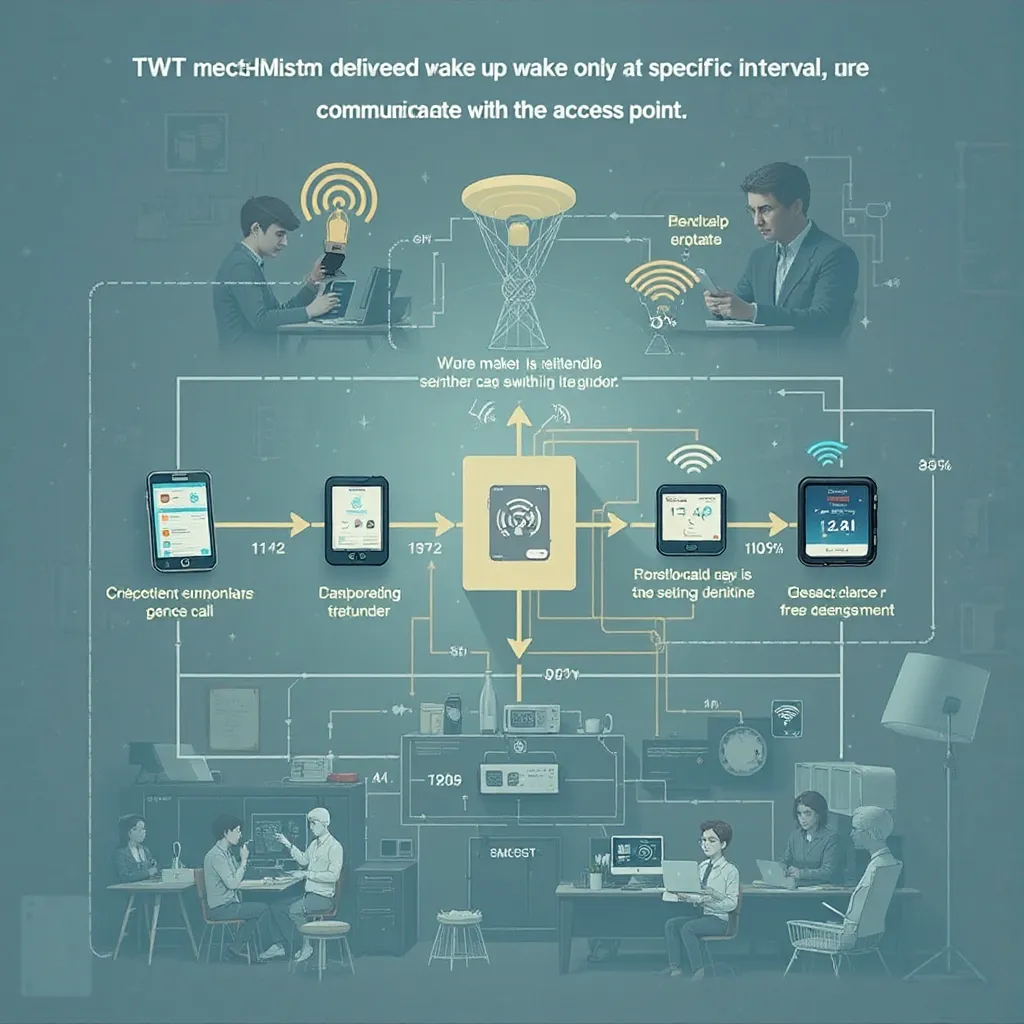1. Introduction
The evolution of wireless continues to transform our daily digital experience. Wi-Fi 6, known in technical standards as IEEE 802.11ax, offers significant upgrades to the previous generations of wireless technologies. One of the most impactful features introduced in this new standard is Target Wake Time (TWT). In this article, we explore in depth the TWT feature in Wi-Fi 6 IEEE 802.11ax, how it works, and why it plays a critical role in saving power, reducing network congestion, and improving overall device performance. This detailed exploration not only provides technical insights but also discusses practical advantages for IoT devices and enterprise applications.

2. Understanding Wi-Fi 6 and IEEE 802.11ax
Wi-Fi 6, or IEEE 802.11ax, represents a major leap forward in wireless networking standards. It is designed to enhance performance, efficiency, and reliability in environments where multiple devices are connected simultaneously. Compared to Wi-Fi 5 (IEEE 802.11ac), this new standard significantly improves network capacities, increases throughput per user by employing advanced technologies such as Orthogonal Frequency Division Multiple Access (OFDMA) and Multi-User Multiple Input Multiple Output (MU-MIMO), and importantly, introduces new power saving mechanisms such as Target Wake Time (TWT).
These improvements are achieved by addressing the inherent challenges of dense wireless environments, where interference and contention can severely impact performance. By optimizing the way devices communicate with access points (APs), IEEE 802.11ax provides a more streamlined and energy-efficient operation. This positions Wi-Fi 6 as the ideal solution for homes, offices, stadiums, and IoT networks where keeping battery-operated devices running for longer periods is essential.(Wikipedia)
3. What is Target Wake Time (TWT)?
Target Wake Time (TWT) is a feature specifically designed to improve power management in Wi-Fi 6 networks. At its core, TWT allows devices to negotiate and schedule specific times to communicate with the AP. This scheduling mechanism means that devices do not need to continuously keep their radios turned on—instead, they can remain in sleep mode for extended periods, waking up only when necessary to transmit or receive data.
In a traditional Wi-Fi network, devices must periodically wake up to listen for beacons and other signals sent by the AP. This constant listening cycle inevitably leads to high power consumption. TWT revolutionizes this model by allowing each device to have its own wake-up schedule that is negotiated with the AP, thereby reducing unnecessary energy use and extending battery life. This is particularly important for IoT devices, which are often battery-powered and expected to operate over long durations without frequent maintenance.(Nordic Developer Academy)

4. How TWT Works in Wi-Fi 6
TWT operates by establishing agreements between the wireless devices and the AP through a negotiation process. There are two primary modes in which TWT can be utilized:
Individual TWT Agreements:
Each device negotiates a unique wake schedule with the AP, meaning that the AP establishes distinct wake durations tailored for each connected station. This customization ensures that battery-operated devices, like sensors and portable gadgets, can conserve energy by only activating their radio interfaces during predetermined intervals.
Broadcast TWT Schedules:
In a broadcast TWT, the AP assigns a common wake schedule for a group of devices simultaneously. This method is particularly useful for environments with many similar devices, such as smart home systems or large-scale sensor networks. By synchronizing wake times across multiple devices, broadcast TWT minimizes wireless contention and further optimizes overall network efficiency.
Both modes aim to reduce the time devices spend in active communication, which significantly decreases overall power consumption and minimizes collisions on the wireless medium. The core process involves a negotiation phase where TWT parameters—such as wake interval, service period duration, and trigger conditions—are exchanged between the AP and the device. Once an agreement is reached, the device follows its schedule and only transitions to an awake state during the allocated time slots.(524wifi)
5. Benefits of TWT in Modern Wireless Networks
The introduction of TWT in Wi-Fi 6 brings several noteworthy benefits that enhance the performance and usability of wireless networks. These benefits are crucial for both everyday users and organizations that rely on robust IoT deployments.
Extended Battery Life for Devices:
By reducing the amount of time a device’s radio remains active, TWT dramatically extends battery life. Devices can remain in sleep mode until it is time to transmit or receive data, thus conserving energy. This is especially critical for IoT applications like remote sensors, security cameras, or wearable devices where changing batteries frequently is impractical or costly.(Socket Telecom)
Reduced Network Congestion:
In dense environments, simultaneous transmissions from multiple devices can lead to congestion and increased latency. TWT helps mitigate this by scheduling communication in a structured manner. When devices wake up in alignment with their agreed schedules, they are less likely to interfere with each other’s transmissions. This scheduling results in fewer collisions and retransmissions, leading to more efficient use of the wireless medium.
Improved User Experience:
Faster response times and lower latency during scheduled communication periods enhance the overall user experience. Even as the network supports numerous devices, users benefit from prompt data delivery and reduced buffering or delays. This reliability is critical in enterprise scenarios, where delayed communication can impact productivity and operations.(UTE)
Enhanced Spectrum Efficiency:
TWT allows for better utilization of available spectrum by reducing unnecessary transmissions. Scheduled wake times mean that the AP can better orchestrate the allocation of time slots and resource units, which in turn improves spectral efficiency and contributes to higher overall network throughput.
Energy Efficiency in IoT Applications:
For IoT devices that transmit data infrequently, the benefits of TWT are particularly pronounced. Devices such as environmental sensors or smart meters often need to communicate only sporadically. With TWT, these devices can operate in ultra-low-power modes between communications, thereby enhancing their operational longevity and reducing maintenance costs.(Espressif)

6. TWT Use Cases in IoT and Enterprise Environments
Target Wake Time is transforming the way devices interact in both consumer and enterprise settings. Its impact spans a diverse array of applications:
Smart Home Systems:
In smart homes, various devices—from lighting systems to security cameras—can use TWT to reduce overall power draw. As each device has a set wake schedule, there is minimal interference and optimized battery usage, keeping the entire network running smoothly without draining individual device batteries.
Industrial IoT:
Manufacturing environments and industrial facilities rely on a dense network of sensors, actuators, and control systems to monitor and manage processes. TWT ensures that these devices can operate continuously with low power consumption. Scheduled wake times reduce the risk of interference in environments where hundreds of devices might be communicating simultaneously, thereby ensuring reliable data collection for critical operations.
Retail and Warehousing:
Retail environments and warehouses are increasingly adopting IoT solutions to track inventory, monitor supply chains, and optimize logistics. With TWT, devices such as barcode scanners, RFID systems, and smart shelving can communicate efficiently without frequent recharging, which minimizes operational downtime and supports continuous monitoring.
Healthcare:
In hospitals and clinics, medical devices must often remain on standby while waiting for critical events. TWT can help reduce power consumption in devices like patient monitors and wearable health sensors. This not only improves battery life but also ensures that data is delivered reliably when needed, thus supporting enhanced patient care and remote monitoring capabilities.
Enterprise Wireless Networks:
Large organizations incorporate thousands of devices in their wireless networks. TWT minimizes broadband waste by ensuring that each device only wakes up to transfer necessary data. This coordinated schedule reduces latency, improves throughput, and minimizes interference, thereby creating a more reliable high-speed network environment for all connected devices.(LinkedIn)

7. Technical Details: TWT Agreements and Modes
Target Wake Time is implemented in Wi-Fi 6 through detailed negotiation protocols and technical parameters that ensure efficient scheduling. The process involves the exchange of information via TWT setup and teardown frames in the management channel. Below are the key technical aspects of how TWT operates:
Negotiation Process:
During the TWT negotiation, devices and the AP exchange TWT elements. These elements include fields such as the TWT Wake Interval Mantissa and TWT Wake Interval Exponent. These values determine the maximum possible sleep duration, which, as specified in the IEEE 802.11ax standard, can reach several years in some cases. This flexible parameterization allows the technology to be tailored to a wide range of applications, from quick-sensing devices to those needing extended sleep periods.
Individual vs. Broadcast TWT:
- Individual TWT: Each device has a personalized agreement with the AP. The TWT parameters for each device, including wake time, service period, and sleep intervals, are negotiated independently. This mode provides personalized power optimization for devices with varying communication needs.
- Broadcast TWT: In environments with a high density of similar devices, the AP assigns a common schedule. Devices subscribing to a broadcast TWT schedule share the same wake-up times, dramatically reducing channel contention among them.
Operation Modes:
TWT supports various operation modes, including Trigger-Enabled and non-Trigger-Enabled modes, and announced versus unannounced service periods. For example, in Trigger-Enabled mode, a device may not have to poll the AP actively since the AP will send out a trigger frame to indicate the start of a scheduled period. In contrast, non-trigger-enabled devices might rely on pre-agreed timings or require periodic polling. These different operation modes provide flexibility, allowing TWT to cater to the power management needs of both high-performance laptops and low-power sensors.(ACM)
8. Integration Challenges and Future Prospects
While the TWT feature offers significant improvements, its integration into existing networks and simulation tools has not been without challenges. Early implementations and simulations—such as those in network simulators like ns-3—have aimed to validate the performance gains of TWT. Researchers have noted some hurdles concerning interoperability with legacy devices, the complexity of scheduling in extremely dense deployments, and the need for refined negotiation protocols to account for real-world dynamics.
Interoperability with Legacy Systems:
One challenge lies in the coexistence of Wi-Fi 6 devices with older Wi-Fi generations. Legacy devices do not support TWT, meaning that APs must continue to serve these devices seamlessly while leveraging TWT for capable devices. This requires finely tuned scheduling algorithms that can optimize network performance without compromising compatibility.
Scheduler Complexity:
Efficiently managing the TWT schedule across hundreds of devices demands advanced scheduling techniques. The AP must dynamically allocate resource units and time slots in such a way that minimizes idle times and maximizes throughput. As the density of devices increases, the scheduler must effectively prevent collisions and ensure that each device’s power-saving schedule is maintained accurately.
Prospects for Future Development:
The growing recognition of the importance of power efficiency in wireless networks suggests that TWT is likely to receive further enhancements in upcoming standards beyond Wi-Fi 6. Future revisions may improve the flexibility of TWT parameters, allowing even finer granularity in wake scheduling. Additionally, as machine learning and AI become more integrated into network management, intelligent predictive algorithms could further optimize TWT scheduling based on real-time network conditions and user behavior.
The integration of TWT into simulation tools like ns-3 marks a crucial step in understanding its performance in diverse operational scenarios. Researchers are optimistic that these studies will contribute to refined industry standards and eventually lead to enhanced commercial products that leverage TWT for maximum energy efficiency.(ACM)

9. Conclusion
Target Wake Time (TWT) in Wi-Fi 6 IEEE 802.11ax is a groundbreaking feature that directly addresses the increasing need for power efficiency and optimized network performance in today’s interconnected world. By allowing devices to negotiate specific wake schedules with the access point, TWT minimizes energy wastage, reduces network congestion, and enhances overall user experience. It plays a pivotal role in making IoT devices more sustainable by extending battery life and reducing maintenance requirements.
As modern environments—from smart homes and enterprise offices to industrial settings—demand high connectivity with minimal power consumption, TWT emerges as one of the key enablers in this shift towards efficient wireless networking. While there remain integration challenges, the ongoing development in simulation and scheduling algorithms continues to improve the efficacy of TWT, pointing towards a future where wireless connectivity is both robust and power-conscious. As Wi-Fi 6 continues to be adopted worldwide, TWT stands out as a vital component in the evolution of wireless networks, setting the stage for even more advanced standards and energy-saving innovations in the years to come.
In summary, TWT fundamentally revolutionizes the way devices manage their wake times, leading to significant power savings, improved network performance, and a reduction in interference in dense environments. As enterprises and consumers increasingly depend on efficient and sustainable wireless networks, embracing technology like TWT in Wi-Fi 6 sets the stage for a more connected and power-smart future.
By understanding the inner workings and benefits of TWT, engineers, researchers, and technology decision-makers can better plan, deploy, and manage networks that not only perform optimally under high loads but also promote long-term device longevity. The technological advancements heralded by Wi-Fi 6 and its power-saving features, particularly TWT, underscore the industry’s commitment to merging high performance with energy efficiency in the digital age.(Espressif)
Embracing TWT in your network deployment strategies could be the key to unlocking unparalleled improvements in battery life, cost savings, and overall network reliability—making it a cornerstone of modern wireless technology.
